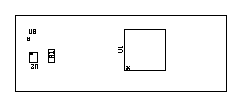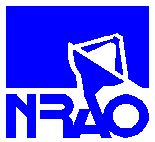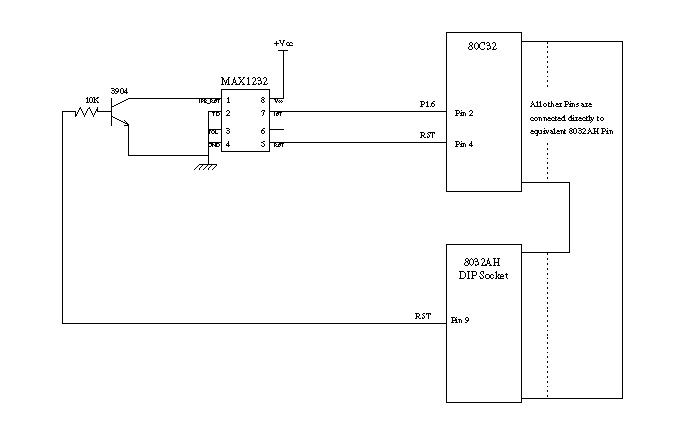


I.1 How to use the SIB Reliability Enhancement
The SIB Reliabiltiy Enhancement requires only two major changes in the original SIB. First, the 8755 EPROM has to be programmed with the Intel hex file that was compiled from the modified code. Then, the 8032AH should be removed and replaced with the SIB Reliability Enhancement. Now, the SIB be will function as it did before except when the watchdog timer times out or Vcc goes below 4.7V.
The SIB Reliability Enhancement's purpose is to protect the SIB from voltage fluctuations and any disturbance that will cause the microcontroller to "stray" from it's routine. The SIB Reliability Enhancement is composed of two main devices, the microcontroller and the monitor chip. The other elements of the design are for interfacing the two main devices with each other and the SIB itself.
The monitor chip is a Maxim MAX1232, and it contains both the voltage control feature and the watchdog timer. The MAX1232 holds the reset outputs in their active states when Vcc goes below the selected tolerance of 5% (Typically 4.62V). The reset pins will remain in their active states until Vcc rises above the 5% tolerance. The watchdog timer must be toggled at least every 150ms. Otherwise the MAX1232 delivers a reseting pulse to the microcontroller.
The SIB Enhancement, physically, is a plug in replacement for the existing 8032AH microcontroller that requires a very minor change in firmware. The enhancement contains a newer 80C32 microcontroller in a quad-flat package. The silk screen and the PCB design are shown below.


The two main constraints upon this project are cost and ease of installation. It is crucial that the device is inexpensive and simple to install to make the enhancement worthwhile. Also, the enhancement obviously has to be compatable with the constraints imposed by the original SIB (voltage levels, active high reset, etc.). Size is another concern. The enhancement has to fit on the board so that it does not impede the mounting of the SIB.
II.3 Description of Schematics

All of the pins on the 80C32 are connected directly to the corresponding location of the pins from the 8032AH* except for P1.6 and RST. P1.6 from the 80C32 (Pin 2) is connected to !ST (Pin 7) of the MAX1232. RST from the 80C32 (Pin 4) is connected to RST of the MAX1232 (Pin 5). RST from the 8032AH (Pin 9) is connected to the 10Kohm resister which in turn is connected to the Base of the 3904 transistor.
The Emitter of the 3904 transistor is connected to ground and the Collector is connected to the !PB_RST of the MAX1232 (Pin 1). TD and TOL of the MAX1232 are connected to ground.
*Please note that when the 8032AH is mentioned here that it is actually refering to the empty 40-pin DIP socket that remains after the 8032AH is removed.
II.4 Vendor Specifications and Data Sheets
Maxim MAX1232 (pdf format, requires Acrobat Reader)
72 Pieces
| Item # | Description | Qty. | Cost Each |
| 1 | Manufactured PC Board | 72 | $3.50 |
| 2 | PCB Photoplot | 1 | $45.00 |
| 3 | PCB Assembly | 72 | $5.00 |
| 4 | Intel S80C32 microcontroller | 72 | $4.90 |
| 5 | Maxim MAX1232CSA Monitoring Chip | 72 | $3.09 |
| 6 | 3904 NPN Transistor, SOT-23 Pkg. | 72 | $0.1363 |
| 7 | 10kohm Resistor, 1/8W, 1% tolerance | 72 | $---- |
| 8 | 100 Ct. Pkg of Mill-Max 3117-200210000080 Printed Circuit Pins | 29 | $6.21 |
| Total Cost | $1189.98 | ||
| Total Cost per Device | $16.53 | ||
100 Pieces
| Item # | Description | Qty. | Cost Each |
| 1 | Manufactured PC Board | 100 | $3.25 |
| 2 | PCB Photoplot | 1 | $45.00 |
| 3 | PCB Assembly | 100 | $5.00 |
| 4 | Intel S80C32 microcontroller | 100 | $3.50 |
| 5 | Maxim MAX1232CSA Monitoring Chip | 100 | $1.82 |
| 6 | 3904 NPN Transistor, SOT-23 Pkg. | 100 | $0.1363 |
| 7 | 10kohm Resistor, 1/8W, 1% tolerance | 100 | $---- |
| 8 | 100 Ct. Pkg of Mill-Max 3117-200210000080 Printed Circuit Pins | 40 | $5.12 |
| Total Cost | $1620.43 | ||
| Total Cost per Device | $16.20 | ||
500 Pieces
| Item # | Description | Qty. | Cost Each |
| 1 | Manufactured PC Board | 500 | $0.80 |
| 2 | PCB Tooling | 1 | $129.00 |
| 3 | PCB Assembly | 500 | $5.00 |
| 4 | Intel S80C32 microcontroller | 500 | $3.25 |
| 5 | Maxim MAX1232CSA Monitoring Chip | 500 | $1.76 |
| 6 | 3904 NPN Transistor, SOT-23 Pkg. | 500 | $0.1363 |
| 7 | 10kohm Resistor, 1/8W, 1% tolerance | 72 | $---- |
| 8 | 100 Ct. Pkg of Mill-Max 3117-200210000080 Printed Circuit Pins | 200 | $3.10 |
| Total Cost | $6213.15 | ||
| Total Cost per Device | $12.43 | ||
Intel Corporation
Product Info. Phone: 1-800-538-3373
Maxim Integrated Products, Inc.
120 San Gabriel Drive
Sunnyvale, CA 94086
Voice: (408)737-7600
Fax: (408)737-7194
Mill-Max Mfg. Corporation
P.O. Box 300
Oyster Bay, NY 11771
Voice: (516)922-6000
Fax: (516)922-9253
Action Circuits Inc. (PCB Manufacture)
P.O. Box 186
Cookstown, NJ 08511-0186
Voice: (609)723-1307
Fax: (609)723-1404
Progressive HyTech (PCB Assembly)
601 Stones Crossing Rd.
Unit 2
Easton, PA 18045-5021
Voice: (610)559-8544
Fax: (610)559-7407
Allied Electronics
7410 Pebble Drive
Fort Worth, TX 76118
Voice: 1-800-433-5700
Newark Electronics (for Mill-Max pins only)
400 Allen Drive
Charleston, WV 25302-3947
Voice: (304)345-3086
Fax: (304)345-3097
Digi-Key Corporation (for 3904 transistor)
701 Brooks Ave. South
Thief River Falls, MN 56701-0677
Voice: 1-800-344-4539
Fax: (218)681-3380